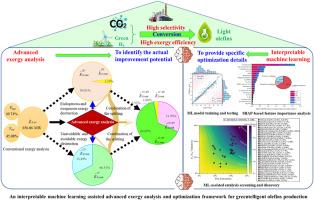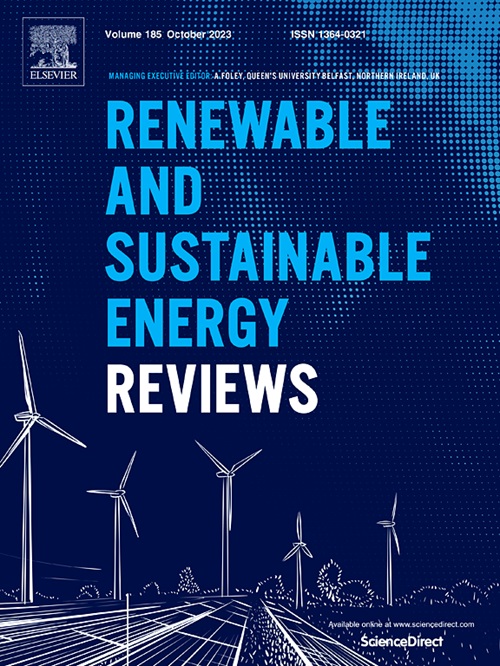Interpretable machine learning-assisted advanced exergy optimization for carbon-neutral olefins production
IF 16.3
1区 工程技术
Q1 ENERGY & FUELS
引用次数: 0
Abstract
The CO2-to-light olefins technology represents a significant approach to mitigating the greenhouse effect and advancing green energy solutions. However, little literature comprehensively analyzes and optimizes its thermodynamic performance. This study proposes an interpretable machine learning-assisted advanced exergy analysis and optimization framework to ascertain the actual improvement potential and determine effective strategies for optimizing this system. The advanced exergy analysis method aims to identify the avoidable exergy destruction and interactions between components of the system, while integrating an interpretable machine learning model to provide the key parameters for enhancing the system's exergy efficiency through feature importance analysis. The findings indicate that the exergy destruction of the system amounts to 656.06 MW, with 96.81 % of this exergy destruction being attributed to endogenous factors and approximately 66.51 % of it being potentially avoidable. The random forest model, exhibiting superior predictive accuracy compared to other machine learning models, is coupled with the interpretable Shapley additive explanation approach to discern the most crucial parameters of the system. Results indicated catalyst properties have the greatest impact on the output performance of the system, contributing up to 66.1 % to the predicted results. The active component type, reaction temperature, and promoter content have the largest contribution to the prediction of CO2 conversion ratio and light olefins selectivity. Furthermore, the key input features are optimized by screening for better catalysts and conducting sensitivity analysis. After optimization, the system's avoidable exergy destruction is significantly saved by 32.27 %, resulting in an enhancement in exergy efficiency by 8.12 %.

针对碳中和烯烃生产的可解释机器学习辅助高级放能优化技术
二氧化碳制轻烯烃技术是缓解温室效应和推进绿色能源解决方案的重要方法。然而,很少有文献对其热力学性能进行全面分析和优化。本研究提出了一种可解释的机器学习辅助高级放能分析和优化框架,以确定实际的改进潜力,并确定优化该系统的有效策略。先进的放能分析方法旨在识别可避免的放能破坏和系统组件之间的相互作用,同时整合可解释的机器学习模型,通过特征重要性分析提供提高系统放能效的关键参数。研究结果表明,该系统的能量损耗达 656.06 兆瓦,其中 96.81% 的能量损耗归因于内生因素,约 66.51% 的能量损耗是可以避免的。与其他机器学习模型相比,随机森林模型具有更高的预测准确性,该模型与可解释的夏普利加法解释方法相结合,可识别出系统中最关键的参数。结果表明,催化剂特性对系统输出性能的影响最大,对预测结果的贡献率高达 66.1%。活性组分类型、反应温度和促进剂含量对二氧化碳转化率和轻烯烃选择性的预测贡献最大。此外,通过筛选更好的催化剂和进行敏感性分析,对关键输入特征进行了优化。优化后,系统可避免的放能破坏显著减少了 32.27%,放能效率提高了 8.12%。
本文章由计算机程序翻译,如有差异,请以英文原文为准。
求助全文
约1分钟内获得全文
求助全文
来源期刊

Renewable and Sustainable Energy Reviews
工程技术-能源与燃料
CiteScore
31.20
自引率
5.70%
发文量
1055
审稿时长
62 days
期刊介绍:
The mission of Renewable and Sustainable Energy Reviews is to disseminate the most compelling and pertinent critical insights in renewable and sustainable energy, fostering collaboration among the research community, private sector, and policy and decision makers. The journal aims to exchange challenges, solutions, innovative concepts, and technologies, contributing to sustainable development, the transition to a low-carbon future, and the attainment of emissions targets outlined by the United Nations Framework Convention on Climate Change.
Renewable and Sustainable Energy Reviews publishes a diverse range of content, including review papers, original research, case studies, and analyses of new technologies, all featuring a substantial review component such as critique, comparison, or analysis. Introducing a distinctive paper type, Expert Insights, the journal presents commissioned mini-reviews authored by field leaders, addressing topics of significant interest. Case studies undergo consideration only if they showcase the work's applicability to other regions or contribute valuable insights to the broader field of renewable and sustainable energy. Notably, a bibliographic or literature review lacking critical analysis is deemed unsuitable for publication.
 求助内容:
求助内容: 应助结果提醒方式:
应助结果提醒方式:


